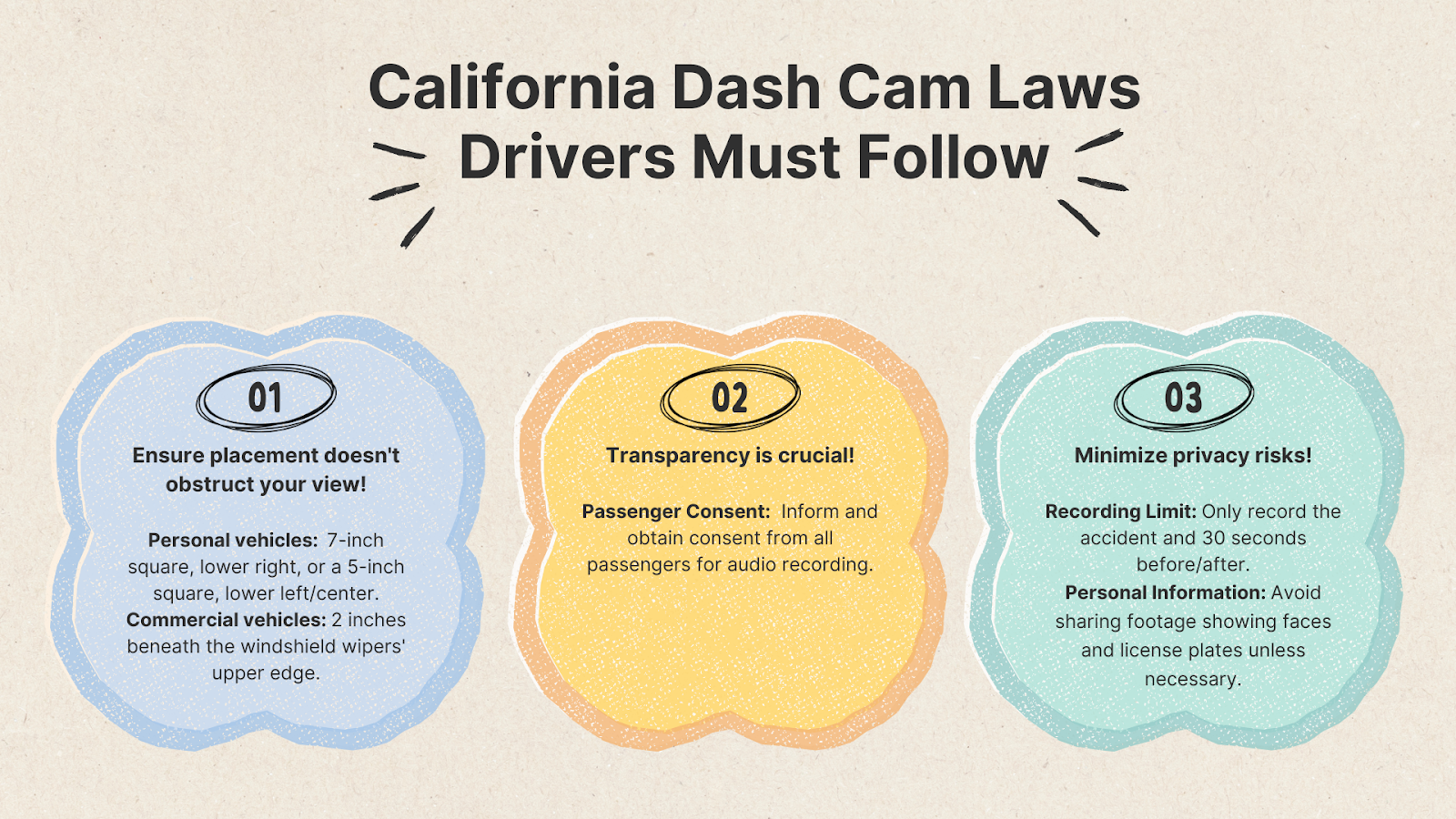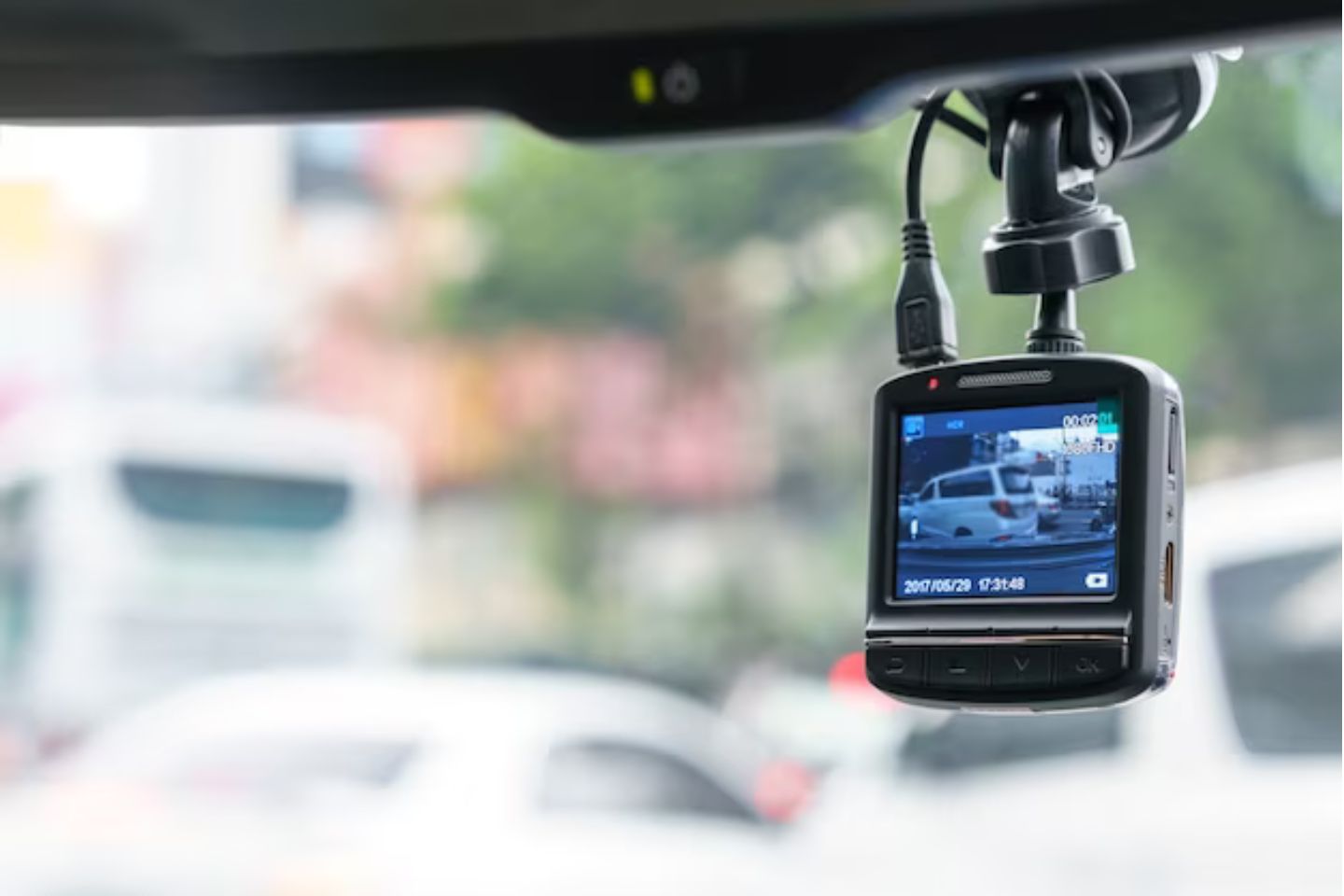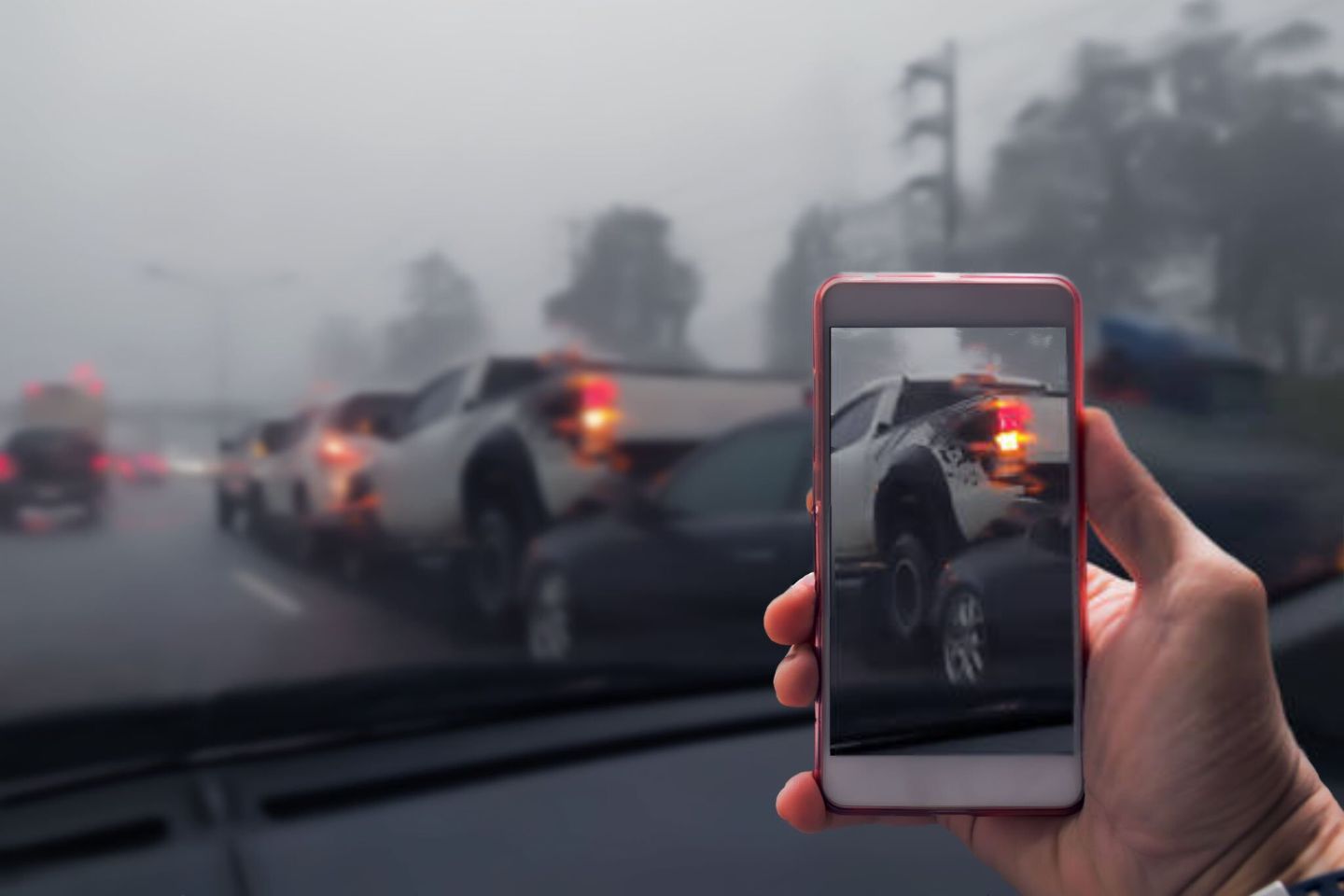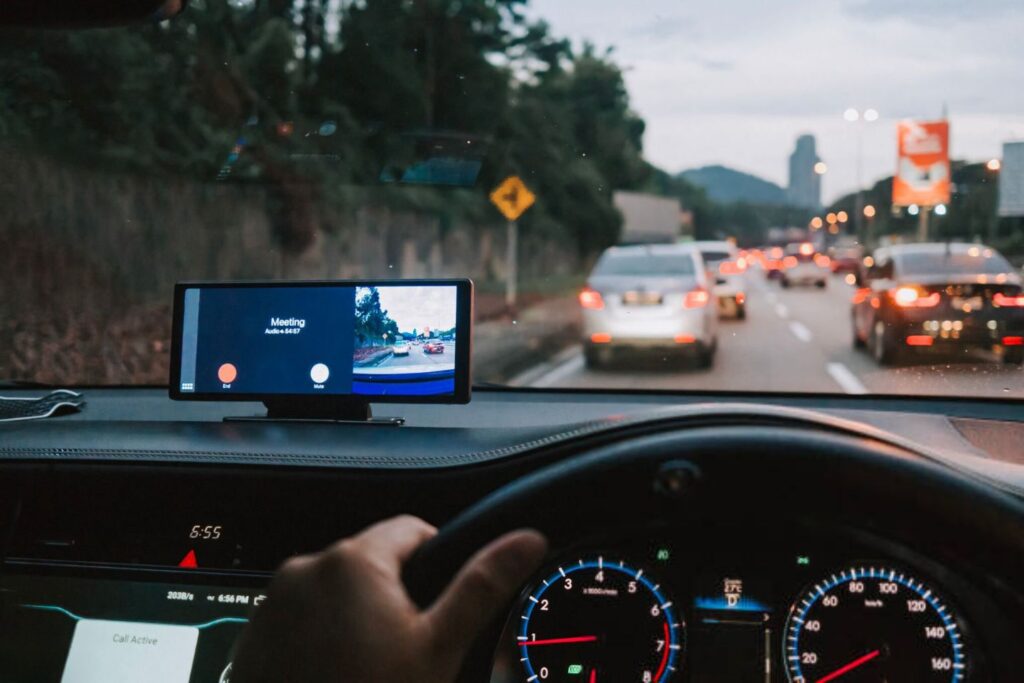In the first six months of 2023, over 2,000 lives were lost on California’s roads, despite a 12% drop in traffic accidents in the first quarter. These numbers from the National Highway Traffic Safety Administration reveal a harsh reality: road fatalities and injuries in California are still at crisis levels.
If you’re ever involved in a traffic accident, a dash cam can be an invaluable tool for capturing evidence. However, it’s crucial to be aware of California dash cam laws, as different states in the US have varied regulations. Knowing these specific laws can significantly impact the effectiveness of your dashcam footage, whether used for personal security or legal reasons.
Here’s what you need to know about these regulations to ensure you’re fully informed and compliant while driving in California.
Is It Legal to Have a Dash Cam in California?
Yes, it’s legal to have a dash cam in California. The state passed legislation in 2011 legalizing the use of dash cams, which are cameras mounted inside vehicles to record the road ahead. However, like most legal matters, there are specific rules and regulations that you must follow to ensure your dashcam usage is in compliance with state laws.
Firstly, it’s important to understand how California law views dashcams. These devices are considered electronic monitoring equipment, and their use is governed under the California Vehicle Code.
The state acknowledges the value of dashcams in capturing potential evidence in traffic incidents or accidents. However, the placement and usage of these cameras must adhere to certain criteria to avoid violations of privacy laws and ensure unobstructed views for drivers.
Laws for Dash Cam Installation and Usage in California


California dash cam laws specifically state the installation and usage rules for these recording devices to ensure safety, privacy, and legal compliance. Here are the things to look out for:
Windshield Placement and Visibility
California is among 12 states that enforce windshield visibility restrictions for devices like dashcams. California Vehicle Code 26078 specifies the allowable size and placement of dash cams to avoid obstructing the driver’s view.
According to this law, dash cams must take up no more than five square inches of space if mounted on the upper center of the windshield, and no more than seven square inches if mounted in the lower right corner.
For commercial vehicles using dash cams to monitor driver behavior, the camera can be mounted no more than two inches beneath the upper edge of the area swept by the windshield wipers, outside the driver’s line of vision.
Audio Recording Consent
When it comes to audio recording in vehicles, California’s dash cam laws require special attention to privacy concerns. Under California Penal Code 632, the state is designated as a “two-party consent” state. This means that if your dashcam is capable of recording audio, the consent of all parties involved in a conversation is necessary.
As a driver, it’s crucial to inform your passengers if your dash cam records audio. This not only fosters transparency but also ensures you’re complying with the legal requirements of California. Failure to inform passengers and obtain their consent could lead to violations of privacy laws.
Data Privacy and Recording Limits
The California Consumer Privacy Act (CCPA) provides guidelines for personal data collection and sharing, applicable to dash cam footage that may capture personal details like faces and license plates.
Additionally, in the event of an accident, the dash cam should record only the incident and 30 seconds before and after it. This practice aligns with privacy concerns and focuses the recording on the most relevant footage.
California Dash Cam Laws for Obtaining Footage


In the landscape of California’s legal system, both parties involved in a car accident claim have specific rights regarding the use and acquisition of dash cam footage.
Filing a Lawsuit for Discovery
If the other party in an accident has a dash cam, your attorney might need to initiate a lawsuit, leading to the discovery phase of the case. During this crucial phase, both parties have the right to request evidence from each other, which includes dash cam footage. Discovery is governed by specific legal procedures, ensuring that each party can access relevant evidence for their claim.
It’s important to comply with these evidence requests, as failure to do so can lead to legal consequences. If a party refuses to provide requested dash cam footage, the court can impose a sanction (a penalty or fine). This is not just a minor issue; sanctions can be significant and are intended to enforce compliance.
Additionally, the attorney who refuses to provide the footage must report this sanction to the State Bar of California. This is essential in maintaining legal ethics and transparency within the state’s legal system.
For example, in a car accident where the fault is disputed, one party may believe that the other’s dash cam footage could clarify the events leading up to the collision. If the dash cam captured moments before the accident, it could reveal crucial details like the status of traffic lights, vehicle speed, road conditions, and driver actions. Such evidence can be pivotal in determining fault, particularly when witness statements or other evidence are inconclusive or conflicting.
Obtaining Police Dash Cam Footage
In situations where you believe your rights may have been violated during an interaction with a police officer, California law empowers you to request access to the officer’s dash cam footage.
Passed in 2018, California Assembly Bill 748 (AB 748) mandates that law enforcement agencies must provide access to their dash cam recordings upon request. This legislation is part of a broader effort to enhance transparency and accountability in law enforcement.
To obtain this footage, you need to submit a formal request under the California Public Records Act to the California Highway Patrol. Be specific in your request by stating “AB 748 Information” in your application. This will clearly communicate that you are seeking dash cam footage under the provisions of AB 748.
How to Use Dash Cam Footage for an Accident Claim?


Dash cam footage can play a pivotal role in the aftermath of a road accident in California, especially concerning personal injury cases and insurance claims. Understanding the legalities and strategic use of this footage is essential in asserting your claim and establishing liability.
Legal Admissibility of Dash Cam Footage
Dashcam footage is generally admissible in California courts, meaning that it can be used as evidence in legal proceedings. The admissibility of this footage hinges on its relevance to your case; it must provide insight into the accident without infringing on privacy laws or being obtained unlawfully. Keep in mind that California’s wiretapping laws, as outlined in California Penal Code § 632, restrict the recording of private conversations without consent.
Maximizing the Use of Dash Cam Footage in Claims
The strategic use of dash cam footage in the wake of a road accident can significantly strengthen your personal injury case or insurance claim in California. Here’s how you can maximize the value of your claim:
Preservation of Dash Cam Footage
It’s crucial to secure your dash cam footage immediately after an accident. Act quickly to ensure this critical evidence is not overwritten, as many dash cams record in loops. This step is fundamental in preserving the integrity and usefulness of the footage.
In-Depth Analytical Review
Analyzing your dashcam footage in detail can reveal key aspects of the accident. Look for the sequence of events, driver behavior, and environmental conditions at the time of the accident. This helps in constructing a factual and detailed narrative of the incident.
Consulting a professional lawyer is essential. In case of an accident resulting in injuries, The Personal Injury Center can connect you with expert attorneys who specialize in navigating the complexities of dashcam footage in legal cases. A lawyer’s guidance is invaluable in evaluating the admissibility and strategic use of your footage according to California’s legal standards.
Strategic Legal Submission of Footage
When considering the submission of your dash cam footage as evidence in an insurance claim or a court case, strategic planning is key. An attorney will assist in presenting your evidence effectively and in compliance with legal procedures and standards.
It’s vital to be aware of the statute of limitations for submitting dash cam footage and filing a claim in California. Typically, personal injury claims must be filed within two years of the accident date. Adhering to this timeframe is crucial for the validity of your case.
Establishing Liability in Personal Injury Cases
Dash cam footage is a powerful tool for establishing liability, particularly in personal injury cases. It can provide clear proof of the other party’s fault, such as running a red light or distracted driving, which can be decisive in speeding up the insurance claim process and strengthening your legal position.
Complementary Evidence to Support Your Claim
To build a robust case, supplement your dashcam footage with other forms of evidence like eyewitness statements, police reports, and expert opinions. This comprehensive approach provides a fuller picture of the incident and bolsters the credibility of your claim.
Navigating Privacy and Ethical Considerations
Be mindful of privacy and ethical issues when using dashcam footage, especially if it captures identifiable individuals or private properties. Handle this sensitive information with the utmost respect for privacy rights and legal obligations.
Handling Your Vehicle Accident Claim the Right Way
Dealing with a vehicle accident in California can be overwhelming, especially when it comes to understanding and utilizing dash cam laws effectively. At The Personal Injury Center, we’re committed to helping you handle your accident claim the right way, ensuring that you’re well-informed and supported throughout the process.
If you’re uncertain about how to use your dash cam footage effectively in a legal claim, or if you need assistance understanding your rights, reach out to us. We’ll connect you with experienced personal injury lawyers who specialize in California dash cam laws.
Key Takeaways
|



